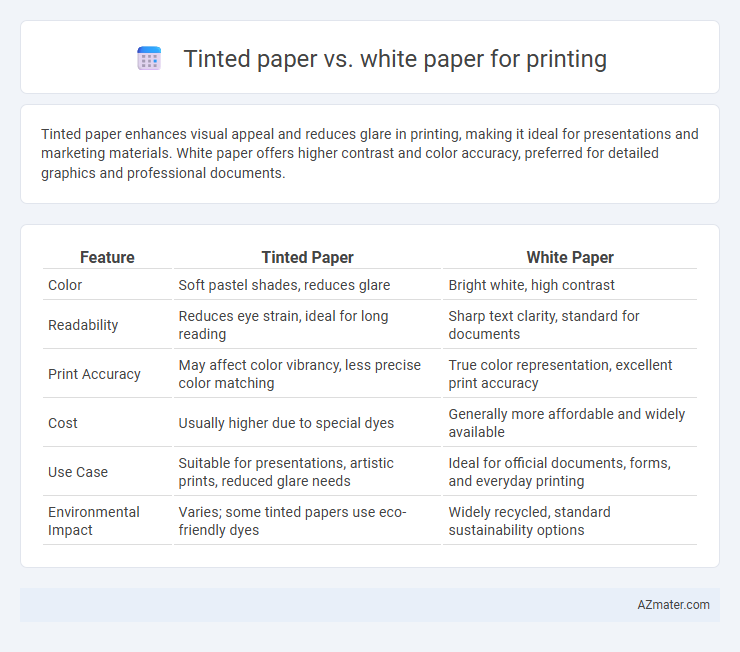Tinted paper enhances visual appeal and reduces glare in printing, making it ideal for presentations and marketing materials. White paper offers higher contrast and color accuracy, preferred for detailed graphics and professional documents.
Table of Comparison
| Feature | Tinted Paper | White Paper |
|---|---|---|
| Color | Soft pastel shades, reduces glare | Bright white, high contrast |
| Readability | Reduces eye strain, ideal for long reading | Sharp text clarity, standard for documents |
| Print Accuracy | May affect color vibrancy, less precise color matching | True color representation, excellent print accuracy |
| Cost | Usually higher due to special dyes | Generally more affordable and widely available |
| Use Case | Suitable for presentations, artistic prints, reduced glare needs | Ideal for official documents, forms, and everyday printing |
| Environmental Impact | Varies; some tinted papers use eco-friendly dyes | Widely recycled, standard sustainability options |
Introduction to Tinted Paper and White Paper
Tinted paper features a subtle color hue, often used to reduce glare and enhance readability, making it suitable for niche printing applications like brochures and flyers. White paper, the standard choice for most printing needs, offers high contrast and clarity, ideal for text-heavy documents and professional presentations. Choosing between tinted and white paper depends on desired visual impact, readability, and the specific printing project's goals.
Key Differences Between Tinted and White Paper
Tinted paper features a colored hue that reduces glare and enhances readability, making it ideal for presentations and creative projects, while white paper offers a neutral background that ensures true color accuracy and sharp contrast in printing. Tinted paper often uses dyes or pigments that can affect ink absorption and print clarity, whereas white paper typically provides consistent ink adhesion and vibrant output due to its bright, reflective surface. Cost and availability also differ, with white paper generally being more widely accessible and economical compared to specialized tinted paper varieties.
Pros and Cons of Tinted Paper for Printing
Tinted paper for printing enhances visual appeal and reduces glare, making it ideal for presentations and artistic projects, while also improving readability for individuals with light sensitivity. However, tinted paper may distort true color reproduction, which can affect the accuracy of printed images and graphics, and often comes at a higher cost compared to standard white paper. Its limited availability and choice of tint shades can restrict design flexibility, posing challenges for professional printing tasks requiring precise color matching.
Advantages and Disadvantages of White Paper
White paper offers high contrast and clarity, making text and images sharp and easy to read, which is ideal for professional documents and detailed graphics. However, it can cause glare and eye strain during extended reading sessions or under bright lighting conditions. While white paper is versatile and widely available at a lower cost, it may not be the best choice for presentations requiring reduced reflection or for reducing visual fatigue.
Print Quality on Tinted vs White Paper
Tinted paper can enhance print quality by reducing glare and improving contrast, making colors appear richer and text easier to read, especially under bright lighting conditions. White paper provides the highest color brightness and sharpness, ensuring accurate color reproduction and crisp detail, crucial for professional printing tasks. Choosing between tinted and white paper depends on desired visual effects and the specific requirements for print clarity and color fidelity.
Cost Comparison: Tinted Paper vs White Paper
White paper remains the most cost-effective option for high-volume printing due to its widespread availability and lower manufacturing expenses. Tinted paper typically incurs higher costs because of added dyes and specialized production processes, increasing the price per sheet by 15-30% compared to standard white sheets. Businesses seeking budget-friendly solutions often favor white paper unless the unique aesthetic or branding benefits of tinted paper justify the additional investment.
Environmental Impact of Tinted and White Paper
Tinted paper typically uses fewer bleaching chemicals compared to white paper, resulting in a lower release of harmful pollutants and reduced environmental impact during production. White paper requires intense bleaching processes to achieve its bright appearance, which increases chemical usage and energy consumption, contributing to higher greenhouse gas emissions. Choosing tinted paper can support eco-friendly printing practices by minimizing chemical waste and conserving resources throughout the paper manufacturing cycle.
Best Uses for Tinted Paper in Printing
Tinted paper offers unique advantages in printing applications such as enhancing visual appeal and reducing glare, making it ideal for marketing materials, invitations, and forms that require contrast or a vintage look. Its subtle color tones improve readability and can differentiate documents in organizational settings, while also helping to conceal imperfections or smudges on the printed page. Common tints include pastel shades like cream, blue, and gray, which complement different ink colors and contribute to brand identity and design aesthetics.
Ideal Applications for White Paper
White paper is ideal for professional documents, reports, and formal communication due to its high contrast and clarity, ensuring crisp text and vibrant color reproduction. It is preferred for business contracts, legal papers, and academic materials where readability and a clean, neutral background are essential. Additionally, white paper's compatibility with various printing technologies makes it a versatile choice for high-quality laser and inkjet printing jobs.
How to Choose the Right Paper for Your Printing Needs
Choosing the right paper for printing depends on factors like purpose, readability, and aesthetics; tinted paper reduces glare and enhances readability in bright environments, making it ideal for presentations or artistic prints, while white paper provides high contrast and clarity, suitable for detailed text and images. Consider the printer compatibility and the type of ink used to ensure optimal print quality and durability on both tinted and white papers. Analyzing the paper's weight, finish, and brightness helps tailor the selection to specific projects, balancing visual impact with functional requirements.

Infographic: Tinted paper vs White paper for Printing
 azmater.com
azmater.com